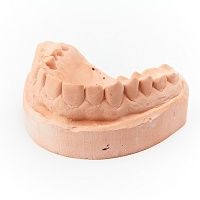Is the Era of Digital Dentistry Finally Here?
Digital dentistry has been around longer than you think -- much longer. One industry executive says he believes wide adoption of the technology is finally on the horizon, with consumer demand driving the uptick.

Quick trivia question: How long has digital dentistry been around?
Five years? Guess again. Ten? Not even close. How about 25. That’s right—25 years. The technology has been around for quite some time. And yet, according to Derek Diasti, CEO of Sun Dental Labs, only 5% of dentists are taking advantage of it.
“About 95% of dentists still take traditional impressions,” Diasti says. “They put that silicon material in your mouth, you bite down on it to make an impression, and then they send it to a lab.”
That’s time and money not necessarily well spent.
Slow Adoption
Diasti says there are several reasons for the slow adoption of digital dentistry: cost, complexity, and consumers. But a lot has changed over the last few years, particularly in the area of cost and complexity.
“It’s a lot simpler to do teeth today than it was two years ago,” Diasti explains. “Previously, the technology was not user friendly.”
Dentists, Diasti says, would take a visual scan of the patient’s mouth, design the tooth, and mill the tooth in their office—virtually becoming a dentist in a lab. The work could be done the same day, but it was a cumbersome process that was also very expensive. In addition, consumer demand was non-existent.
“There’s a lack of consumer knowledge,” Diasti says. “They should not accept a traditional impression, because digital is here, it’s good, it’s high quality, and it’s efficient.”
Sun Dental Labs has developed a digital “workflow” that involves using an intraoral scan that creates a digital impression of the patient’s mouth. The dentist can check the image immediately on a laptop to make certain all is right with the impression. Then the image is sent electronically to the lab where dental technicians create the needed restoration.
The Digital Solution
Diasti says that the workflow, which the company calls digital solutions, is easy to work with. Dentists can purchase the digital scanner from Sun Dental or anyone else.
“We’re agnostic to the digital scanner,” he says. “You just download our user interface, and that’s it. You can see the design on your laptop, and approve it before it goes to machining. Basically, you’re taking a 3-D copy of the tooth.”
The digital solution is also cost effective. Diasti says that the scanner, software, warranties, and training cost $299 per month. So, if the cost of one impression is regularly $30 and the dentist does just 10 impressions a month, the digital solution pays for itself.
“And the data is stored in a cloud forever,” Diasti says. “If you have a broken tooth, if the patient needs to come back, you just go back into the cloud and order a new tooth. If the shade is different, you can just change the shade. It has really gone from analog to digital. You have access to all your data, and you don’t have to wait until the lab opens up on Monday morning. You can see everything.”
The one-day training can even be done online. For example, if a patient has a 10 o’clock appointment and the dentist contacts Sun Dental ahead of time, the technicians can log into the dentist’s scanner and computer and walk the dentist through the process.
Streamlined Process
Diasti says the digital solutions process is extremely efficient compared to traditional methods. With conventional methods, the dentist preps the tooth, and the dental assistant has to mix the putty in a tray to take the first impression—which then sits in the patient’s mouth for several minutes. Once the impression is completed, it must be shipped to the lab, which adds another day or two to the process.
“And then they have to pour a stone model in the impression to see if it’s a good impression,” Diasti says. “So that’s a second or third day. With [the digital workflow] you can tell that immediately.”
In addition, Diasti says that dental assistants can perform the scanning, making more productive use of their time, and freeing up the dentist to do other work.
“All the dentist has to do is make sure it looks good.”
Change Is Coming
Diasti says one of the more important benefits of digital dentistry is the improved patient experience.
“I really believe that in the next five to 10 years consumers are going to drive this change,” he says. “And this is smart business. It’s faster, cheaper, more efficient and more comfortable. If you want to stay in business, it’s a differentiator.”
Younger dentists, he says, will also drive the change.
“They’re the Apple generation,” Diasti says. “That’s what they’re used to. It’s not going to be difficult for them to adopt. They will demand it.”